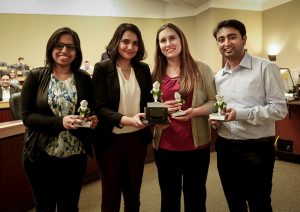“How can you do the impossible?” This is just one of the questions that MBA students at Michigan State University’s Broad College of Business faced on the second day of Extreme Green.
Extreme Green is the Broad College’s short, four-part workshop-style course, designed to tap into MBA students’ creativity through experiential learning. Extreme Green 1 and 2 target first-year MBAs, while Extreme Green 3 and 4 include second-years.
In each of the four levels of the course, MBA students work with Fortune 500 companies, ranging from automotive giants to consumer goods companies, to create innovative solutions to real-world problems. The course uses an evidence-based, hands-on approach to prepare students for the uncertainties of 21st century business.
The three-day program took place from March 1st to March 3rd. First-year MBAs focused on creative problem solving with corporate partner Disney, while second-year MBAs refined their entrepreneurial and presentation skills in a live pitch.
“The world is unpredictable, ambiguous, and complex, which makes it exciting and full of opportunity. Using creativity to solve problems is the kind of approach we need,” said Tricia Garwood, featured speaker and a leadership development manager at Disney. “Everything is changing so quickly, which means we have to be more agile. Creativity and innovation is about being agile and being able to imagine new and varied answers and possibilities.”
First-year MBAs focused on developing, understanding, and honing the creative mindset with a series of brief assessments to identify their key strengths, as well as preferences in regards to problem solving and collaborating. Then, students exercised their strengths to spark individual and team creativity. Facilitators led discussions around creativity versus innovation, and understanding how deliberate creativity leads to innovative behaviors.
Second-year MBAs were introduced to a business case to which they would then apply their key strengths, as well as what they learned during Extreme Green workshops thus far. On the final day, each team presented their original business concept in a Shark Tank-style competition, using the skills of the Creative Problem Solving Method.

The winning MBA team used the creative problem-solving skills and strategies cultivated during Extreme Green to present their live business case.
The winning team, which presented a business proposition for a customizable, fresh, food delivery service called “Lettuce Celebrate,” took home the winning title for Extreme Green. The team leveraged food industry data to forecast their business’ success, as well conducting an in-depth market analysis to shape their strategy. The judges noted the winning team’s creative approach to marketing and overcoming competitive obstacles.
The origins of creative problem solving formally began with Alex Osborn of BBDO advertising agency, who coined the term “brainstorming.” Osborn, along with Sid Parnes, co-founded the Creative Studies Program at Buffalo State College. It was during this time that they also held the first annual Creative Problem Solving Institute (CPSI) at SUNY Buffalo State University. Kristen Peterson, the other featured speaker at the event, is now the director of CPSI. In addition to directing CPSI, Peterson is a creativity and innovation facilitator, trainer, coach, and catalyst. She also runs a similar three-day conference focusing on creative problem solving in Canada called Mindcamp.
Extreme Green marks the first time this specific creative problem-solving presentation was given to MBA students rather than professionals. By the end of Extreme Green, students walked away with strategies to “achieve the impossible,” as they were challenged the very first day.
“There is an eagerness that the students bring to this, an eagerness to bring new information,” said Garwood. “They want to learn as much as possible and understand how they can use their skills and make an impact.”




